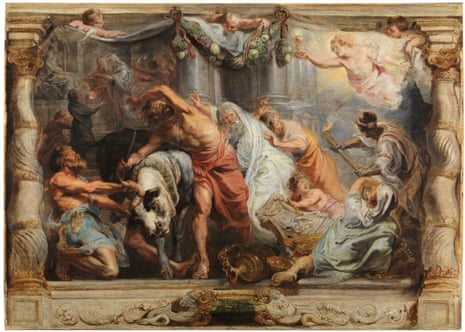Before Peter Paul Rubens set out to execute his landmark series of tapestries The Triumph of the Eucharist, he first painted detailed studies called modelli on oak panels. Over time, the wood began to warp, so preservationists of the period affixed wooden lattices on the backs to hold them flat. It worked for a while, but the rigid cradles would not accommodate expansion and shrinkage caused by temperature variations. Cracks began to form, compelling modern-day preservationists to unfix the fixes of their renaissance brethren.
“It’s a very complicated restoration,” says the Prado Museums’s Alejandro Vergara. “The restorers were worried about doing it because you have to remove cradles from the back. So you’re physically tampering with objects that have been together for 400 years.”
Nuanced works in their own right, the modelli required four years of restoration courtesy of the Getty foundation’s $380,000 grant as part of their panel paintings initiative, working in conjunction with the Prado. In the end, restorers replaced the lattices with new ones accommodating micro-movements in the wood while still holding the artwork flat.
Their work is part of what makes Spectacular Rubens: the Triumph of the Eucharist, the Getty Museum’s new exhibit, so breathtaking. On display in Los Angeles through 11 January are four of the 20 tapestries the artist designed along with six of the stunning modelli portraying the scenes in their original colours, which sharply contrast with their faded counterparts.
Appointed in 1609, Rubens was court painter for Albert VII of Austria whose widow, Infanta Isabel Clara Eugenia, turned to him as a confidant after her husband’s death in 1621. It was during this period she handed the artist one of the biggest commissions in Europe, and certainly a landmark in his career; a series of tapestries celebrating the glory of the Roman Catholic church.
Measuring an average of five by seven meters, the silk and wool wall-hangings weigh hundreds of kilos and took roughly eight years to complete. (Belgian weavers, the finest in the world, could take a year to finish one square meter.) The scenes on them are allegorical. The Triumph of Truth over Heresy portrays a bright angel of truth descending on fleeing pagans. The Israelites Gathering Manna in the Desert, shows a father figure hailing the heavens for their beneficence as the women and children collect the life-giving gift. The tapestries were donated by Isabel to Madrid’s Monasterio de las Descalzas Reales (Convent of the Royal Barefoot Nuns).
“He’s an artist at the very peak of any artistic activity in this period,” says Getty curator Anne Woollett, pointing out Rubens’s distinctive framing elements such as the Solomonic columns and drapes on the edges of subject, forming a picture within a picture. “To be innovative, to be the person that others follow is very natural. This is such an important commission: he’s done something very special. Isabel is a woman he knows, [that] he’s worked with. It’s about doing something that’s profoundly important to him.”
When told of the Prado’s request to borrow some of the tapestries to show alongside the modelli, the Mother Superior of the Convent of the Barefoot Royals wondered why they didn’t just bring the modelli to the convent. It was a reasonable suggestion unless you consider a 2010 Rubens exhibition at the Prado drew over 300,000 art lovers.
“Our job in a museum is to conserve and to study and to let people know about art,” Vergara recalls how he explained to the convent why the Prado, and now the Getty are more appropriate venues. “A project like this, we’re drawing people into the museum and allowing them to enjoy it. When a museum does something, a lot of people come to see it.”
- Spectacular Rubens: The Triumph of the Eucharist is on display at the Getty Centre in Los Angeles until 11 January. Details here.
- This article was amended on 30 October 2014 to correct the amount of the restoration fund. The picture was also changed; the previous one was a copy of the original work.

Comments (…)
Sign in or create your Guardian account to join the discussion